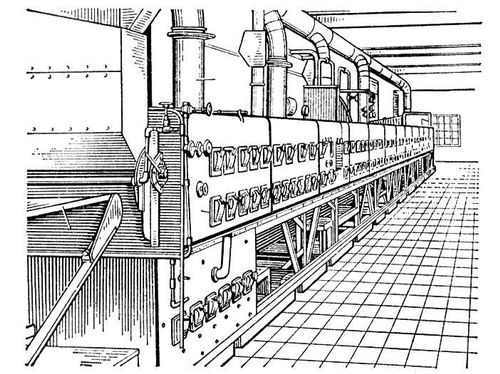HEAT TREATMENT EQUIPMENT FOR FASTENERS, METALWARE AND PARTS
CONVEYOR FURNACES GENERAL INFORMATION
- Heat treatment
- Continuous furnace
- Pit/Bell type furnace
- Vacuum furnace
- Turn-key projects
CONVEYOR FURNACES FOR HARDENING WITH SUBSEQUENT DRAWING AND CARBONITRIDING
Conveyor furnace may carry out a variety of heat treatment processes, from carburization, carbonitriding, tempering hardening in oil or water, polymers or salts. They are broadly applicable to a large number of different heat treatment of small items such as bolts, screws, bearings, small size stampings. Automatic conveyor line with electric or gas heating may include:
- System for loading and processing of the material.
- Device for weighing and batching.
- Hardening and tempering furnaces.
- Washing machines for screws or belts.
- Oil separator and centrifuge.
- Tank for products hardening and polishing.
- System control instrumentation.

CONTINUOUS CONVEYOR FURNACES FOR ANNEALING AND SOLDERING TO SOLUTION HARDENING FURNACES
One of the main features of continuous conveyor furnaces is uniform heat treatment. Blanks are sequentially arranged and distributed on the conveyor line and thus pass all the necessary temperature gradients during the heat treatment. Gas or electricity can be a heat source, using different protective atmospheres depending on the type of heat treatment:
- soldering
- annealing
- solution hardening
- solid hardening (for alloys hardening)
The most common type of heat treatment is soldering that joins together different metals (steel, stainless steel, copper, bronze, brass, aluminum, etc.). Weldable material usually consists of solder paste or metal, that are placed directly on the soldering area.
CONTINUOUS CONVEYOR FURNACES FOR OXIDIZING AND DEOXIDIZATION
- Heat treatment is performed at high temperatures in furnaces of this type, in corresponding gaseous environment, that directly causes changes in the chemical composition of the treated materials surface.
- Conveyor continuous furnace is used for deoxidization of the metal oxide powder (e.g., copper, iron, stainless steel). Transport system for processed products is a conveyor of heat resistant steel that moves forward. The volume of the protective gas inside the furnace is reduced during operation.
- Oxide of black and blue color, guided along the conveyor line consists of iron oxide and is resistant to atmospheric corrosion. Baking takes place in the presence of superheated steam. The porous material, which is formed by baked powder particles, has waterproof properties and higher hardness (e.g., pistons for refrigeration compressors).
- In the case of magnetic cores for electric engines and transformers, controlled oxidation is formed of insulating material capable of limiting the hysteresis (lagging behind, phase lag) and parasitic currents generated by magnetic field energy.
- Along with heat treatment, annealing is also the case that increases the permeability of the laminar units formed from the previously mentioned magnetic cores. In the heat treatment, it is possible to use superheated steam and exothermic gas which is produced by combustion of the air / hydrocarbon fuel.
CONVEYOR FURNACES FOR SINTERING
One of the main features of continuous conveyor furnaces is uniform heat treatment. Blanks are sequentially arranged and distributed on the conveyor line and thus pass all the necessary temperature gradients during the heat treatment. Gas or electricity can be a heat source, using different protective atmospheres depending on the type of heat treatment:
- sintering
- sintering/ solid hardening (for alloys hardening).
Particular attention is paid to the design and construction of continuous conveyor furnaces for baking-hardening of parts obtained by compressing the metal powders. This process does not require additional heat treatment cycles. Finished products are at your disposal.